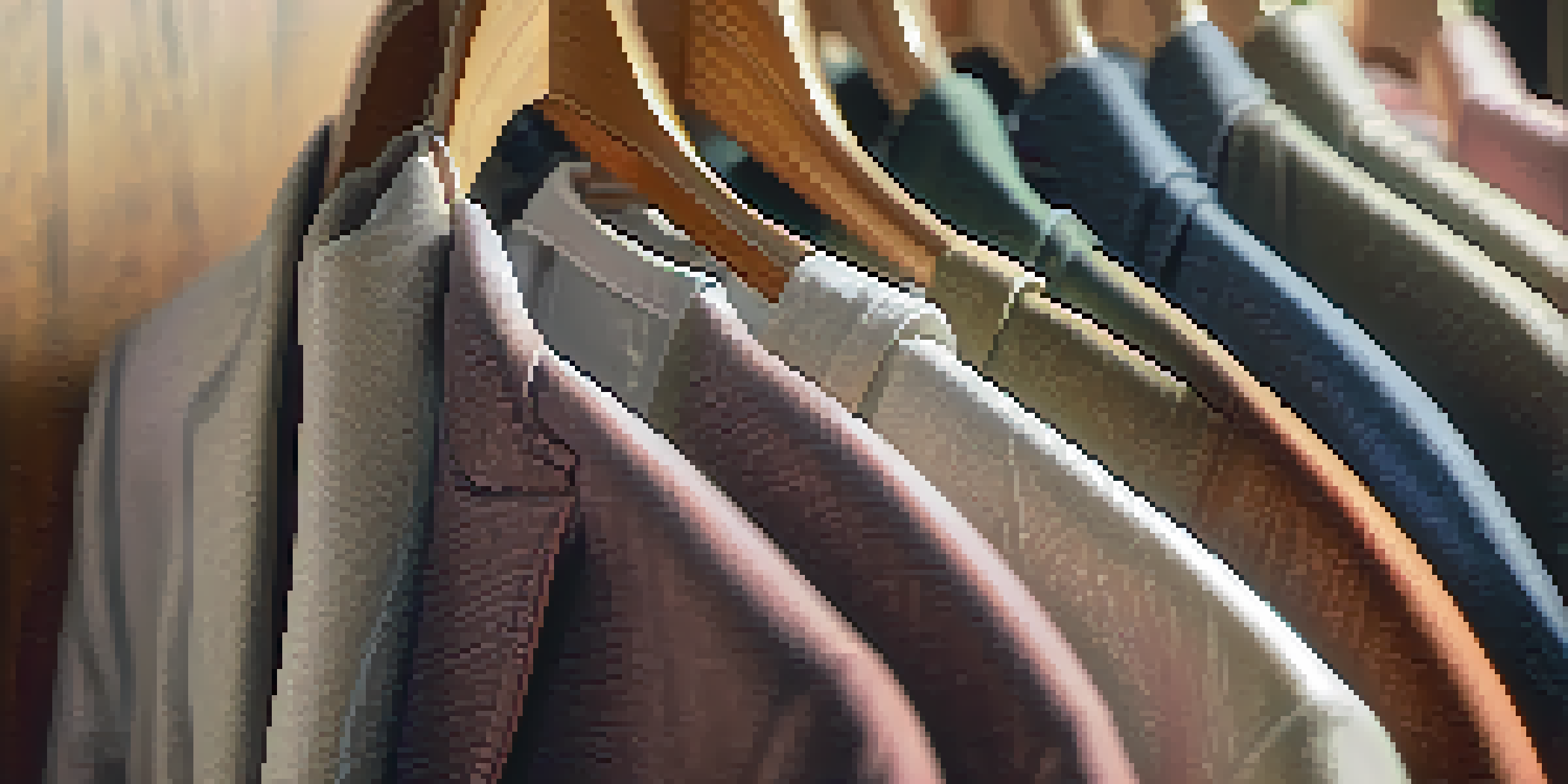Smart Fabrics: Emerging Startups Creating Innovative Textiles

What Are Smart Fabrics and Why They Matter
Smart fabrics, also known as e-textiles, are textiles that are embedded with digital components. These innovative materials can interact with their environment, providing functionality beyond traditional fabrics. For example, they can monitor body temperature, track movements, or even change color based on light exposure.
The future of clothing is about to change in ways we can't even imagine, thanks to smart fabrics.
The significance of smart fabrics lies in their potential applications across various industries. From healthcare, where they can track vital signs, to fashion, where they can create dynamic designs, the possibilities are endless. This merging of technology and textiles represents a new frontier in material science.
As we increasingly integrate technology into our daily lives, smart fabrics provide a seamless way to enhance our experiences. Imagine a jacket that adjusts its insulation based on the weather or workout gear that helps optimize performance through real-time feedback.
Key Features of Smart Fabrics
Smart fabrics boast several key features that set them apart from traditional textiles. They can be conductive, allowing them to transmit electrical signals, or they may incorporate sensors to collect data about the wearer's physical state. This ability to process information enhances their functionality significantly.

Another vital characteristic is their adaptability. Some smart fabrics can change their properties based on environmental stimuli, such as temperature or moisture levels. For instance, fabrics that tighten or loosen for better fit and comfort can revolutionize how we think about clothing.
Smart Fabrics Enhance Daily Life
Smart fabrics integrate technology into textiles, enabling features like health monitoring and environmental adaptability.
Lastly, many smart fabrics are designed to be durable and washable, making them practical for everyday use. This durability ensures that the technology can withstand the rigors of daily life without sacrificing performance.
Emerging Startups in the Smart Fabrics Space
A multitude of startups are pioneering advancements in smart fabrics, each bringing unique innovations to the market. Companies like Wearable X are merging technology with fashion, creating yoga pants that provide feedback on posture. Their products exemplify how smart fabrics can enhance physical activities while maintaining style.
Smart fabrics are the ultimate fusion of technology and textiles, redefining how we interact with our clothing.
Another notable startup, Myant, focuses on integrating textiles with health-monitoring technologies. Their garments can track heart rate and other vital signs, effectively turning everyday clothing into wearable health devices. This intersection of health and fashion opens up new avenues for proactive wellness.
Finally, companies like Vollebak are exploring the use of advanced materials for outdoor gear. Their products, featuring self-repairing fabrics and color-changing technology, showcase how smart fabrics can revolutionize performance wear, making it more functional and sustainable.
Applications of Smart Fabrics in Fashion
The fashion industry is experiencing a transformative shift with the integration of smart fabrics. Designers are now able to create garments that not only look good but also serve a functional purpose, catering to the needs of tech-savvy consumers. This trend is paving the way for a new era in fashion that prioritizes both aesthetics and utility.
For instance, brands are developing clothing that can change colors or patterns at the touch of a button, offering consumers customizable styles. This innovation allows individuals to express their personalities uniquely, adapting their outfits to suit different occasions or moods.
Innovations Reshape Fashion Industry
The fashion industry is embracing smart fabrics to create functional garments that cater to tech-savvy consumers.
Moreover, smart fabrics can enhance comfort through temperature regulation and moisture-wicking properties, making them ideal for active lifestyles. As the demand for multifunctional clothing rises, designers are embracing smart textiles to meet consumer expectations and create a more immersive fashion experience.
Healthcare Innovations with Smart Fabrics
In the healthcare sector, smart fabrics are revolutionizing patient care and monitoring. Wearable devices integrated into textiles can continuously track health metrics, providing valuable data to healthcare professionals. This real-time monitoring can lead to quicker interventions and improved patient outcomes.
For example, smart textiles can be used in hospital settings to monitor patients' vital signs without the need for cumbersome equipment. This comfort can lead to a better overall experience for patients, allowing them to move freely while still being closely monitored.
Additionally, the potential for smart fabrics to administer medication or provide therapeutic support is being explored. Imagine bandages that release medication as needed or garments that apply gentle pressure for pain relief, showcasing the limitless possibilities of integrating technology into healthcare.
Sustainability and Smart Fabrics
Sustainability is a growing concern in the textile industry, and smart fabrics are stepping up to address these issues. Many startups are focusing on creating eco-friendly textiles that not only reduce waste but also enhance the lifecycle of products. This shift toward sustainability is crucial in the fight against environmental degradation.
For instance, some smart fabrics are made from recycled materials, reducing the need for virgin resources. Others are designed to be biodegradable, ensuring that when they reach the end of their life cycle, they won't contribute to landfill waste. This approach aligns with consumers' increasing demand for sustainable products.
Sustainable Solutions in Textiles
Many smart fabrics are developed with sustainability in mind, utilizing recycled materials and promoting durability to reduce waste.
Moreover, the durability of smart fabrics means they can last longer, minimizing the need for frequent replacements. This longevity not only benefits consumers but also helps brands build a more sustainable business model, demonstrating that innovation and environmental responsibility can go hand in hand.
Future Trends in Smart Fabrics
As technology continues to evolve, the future of smart fabrics looks promising. We can expect to see even more sophisticated materials that can not only gather data but also respond to it in real-time. This intelligence will enable garments to adapt dynamically to the wearer's needs, creating a truly personalized experience.
Additionally, advancements in connectivity will likely lead to more seamless integration with smartphones and other devices. Imagine clothing that syncs with your smartwatch to provide real-time feedback on your health and performance, making it easier to achieve your fitness goals.

Finally, as the demand for smart fabrics increases, we may witness a rise in collaborations between tech companies and fashion brands. This synergy can lead to groundbreaking innovations that blend style with cutting-edge technology, ultimately reshaping the landscape of both industries.